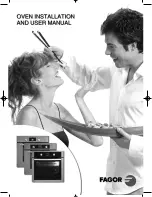
BEFORE USE
GB 5
■
A useful rule when using the microwave
oven is: doubling the quantity of food
means doubling the cooking time.
■
Covering the food prevents it spattering,
shortens the cooking time and helps to
retain moisture.
■
The door may be opened if the microwave
oven is switched on: the microwave oven
then switches itself off automatically and
the cooking time is stopped.
■
Not all materials are suitable for use in the
combi-microwave oven. The table below
shows which materials you can use and
which you cannot.
Material
Microwave
Hot-air function Combination
Grill
paper
yes
no
no
no
aluminium foil
to cover*
yes
to cover*
yes
cling film
yes
no
no
no
aluminium trays
no
yes
no
yes
freezer / microwave dishes
yes
no
no
no
heat-resistant plastic
yes
no
no
no
unglazed earthenware
no
yes
no
yes
metal cooking utensils
no
yes
no
yes
normal glass
yes
no
no
no
Pyrex, other ovenproof glass
and ceramics
yes
yes
yes
yes
dishes with metallic decoration no
**
no
**
metallic twists
no
yes
no
n/a
mercury thermometer
no
yes
no
yes
sealed pots
no
n/a
n/a
n/a
bottle with narrow neck
no
n/a
n/a
n/a
roasting bags
yes
yes
yes
no
* By covering thinner pieces of food (such as chicken legs) you prevent them cooking too quickly.
** If in doubt, consult the manufacturer’s instructions on the packaging of the cooking utensil.
BEFORE USE
GB 4
Before first use
■
Open the door and remove the packaging
material.
■
Clean the inside of the oven and the
accessories with a damp cloth. Do not use
an abrasive cleaner or any strongly-
smelling detergents.
■
Place the roller stay in the middle of the
oven. Place the turntable on top of the
roller stay.
■
The microwave oven may not be used
without the roller stay or turntable.
■
Do not operate the oven when empty.
■
Check that the microwave oven is working
correctly. Put a glass of water inside it.
Switch the microwave oven on for one
minute on its highest setting (see page 7,
cooking). At the end of this time, the water
should be hot.
NB:
If you want to boil a liquid (e.g. water), put a
plastic spoon in the cup. It is possible that the
liquid will boil without you seeing any
bubbles. When you remove the cup from the
oven, the liquid may start to boil violently and
splash out of the cup, with the risk of
scalding.
If you heat small amounts of powdery
products in the microwave oven (for example,
when drying herbs), there is a chance that
they will spontaneously combust. Should a
fire start in the microwave oven, keep the
door closed, switch the microwave oven off
and disconnect the appliance from the power
supply.
Points for your attention
■
The microwave oven is not suitable for:
– Making preserves.
– Cooking eggs in their shells, because
these burst due to the increase in
pressure.
– Heating oil for deep-frying.
■
Remove metal closures from plastic bags
and use dishes and plates which are
suitable for the microwave oven.
■
You may only heat liquids in airtight
packaging if you first prick the packaging.
This is because of the increase in pressure
which occurs during heating.
■
Never heat things for longer than is
necessary; take the "standing time" into
account.
■
Use as little water as possible when
cooking food and be sparing with salt.
■
Stir or turn dishes halfway through the
cooking time.
■
Prick the packaging of meat, chicken and
fish with a fork or any other pointed object.
This prevents these foods bursting.
















































